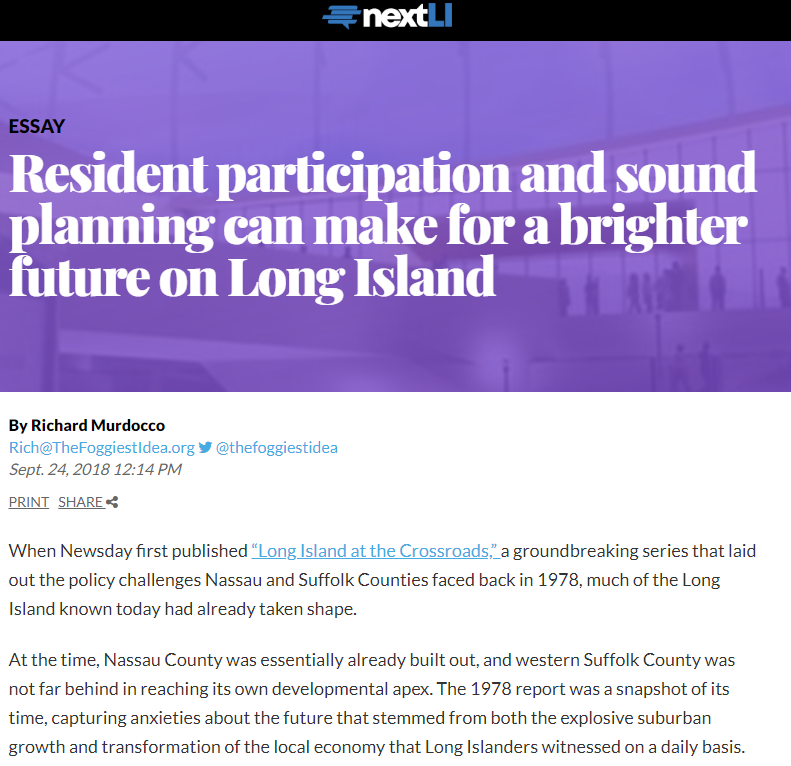The following essay was published by NextLI, an project launched by Newsday in order to discuss the future and foster consensus around ways to make the Nassau/Suffolk region competitive, affordable and welcoming. NextLI is managed by Newsday’s Opinion department with input from an advisory board made up of Long Islanders. It is funded by a charitable project grant from The Rauch Foundation. You can read the original version here.
When Newsday first published “Long Island at the Crossroads,” a groundbreaking series that laid out the policy challenges Nassau and Suffolk Counties faced back in 1978, much of the Long Island known today had already taken shape.
At the time, Nassau County was essentially already built out, and western Suffolk County was not far behind in reaching its own developmental apex. The 1978 report was a snapshot of its time, capturing anxieties about the future that stemmed from both the explosive suburban growth and transformation of the local economy that Long Islanders witnessed on a daily basis.
In the years following the report, the frenzy was slowed as vacant space became scarcer, resulting in the enacting of policies that focused on farmland, open space, and groundwater protections across the Island. In addition, some sizable investments were made in the Island’s infrastructure networks, laying the groundwork for the philosophical roots of many of the transit-oriented projects and proposals on the wish lists of today’s policymakers.
Nowadays, many of the same troubles highlighted then still exist – now amplified by the passage of time. We’ve known for decades what challenges have to be overcome – lowering the cost of taxes and housing, untangling the gridlock of unyielding traffic, and the need to protect our surface and ground waters.
At this point, it’s not a question of what ails us – but finding the political will to implement the complex and often costly solutions that were identified long ago. It is here where the art of planning, a practice that is shaped by resident input and guided by data, becomes critical for ensuring that Long Island has a vibrant future in the coming years.
While any group or individual can formulate a flashy plan complete with attractive renderings and graphs, implementation remains the most important step of the planning process- and serves as the differentiator between these efforts becoming mere dusty books on a shelf or having the opportunity to collectively usher in a new era of suburban prosperity.
The means of overcoming our region’s substantial hurdles can be found through the creative application of planning, and should aim to take a holistic, comprehensive view of what makes Long Island’s suburban landscape unique. In practice, planners strive to balance social, economic, and environmental forces, all of which are interrelated and often competing, and serve to frame out Long Island’s nuanced and challenging policy environment.
In April, I argued on the pages of Newsday that Long Island’s municipalities must stop pursuing patchwork economic development strategies and come together to properly chart the region’s future. The solution proposed to counter these balkanized land use policies is that one entity must step forward and lead the region in a cohesive effort that accounts for the collective dynamics of real estate development.
To diversify our housing stock, nurture long-lasting economic growth and protect our environment, policy actions must go beyond the catchy buzzwords and platitudes Long Islanders have heard touted by industry insiders in recent years. It’s critical that policymakers and elected officials acknowledge both the environmental limitations and suburban realities that Long Island faces. Collectively, residents must give their honest input, remain open-minded to the notion of change – actions that will help local leaders craft tangible, realistic strategies that accommodate the needs of not just millennials, who have been the focal point of land use policy in the last decade, but gen X’ers and baby boomers at the same time.
Richard Murdocco is an award-winning columnist and adjunct professor in Stony Brook University’s public policy graduate program. He regularly writes and speaks about Long Island’s real estate development issues.











